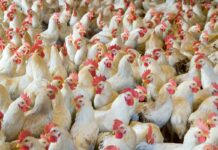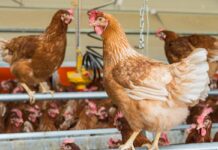
The present experiment was designed to investigate the effects of electrolyte supplementation in alleviating the harmful effects of high temperature for one day prior to transport and processing.
Heat stress is considered one of the important factors affecting the profitability of the poultry industry in hot climates. Significant economic losses occur due to high mortality, impaired feed efficiency and poorer growth rates. Periods of high temperature prior to transport and processing can further compound these adverse effects. One of the physiological consequences of heat stress in broilers is disruption of acid base balance. Electrolyte supplementation is a possible strategy to improve broiler welfare and performance during heat stress. The present experiment investigated the effects of electrolyte supplementation in alleviating the harmful effect of high ambient temperature for one day prior to transport and processing.
Method
Day-old mixed sex Cobb-500 broiler chicks were obtained from a commercial hatchery and transported to the poultry research facility at the University of Sydney. The birds were reared in 36 floor pens, 3 blocks of 12 pens, in a tunnel-ventilated shed. The birds were fed ad libitum a starter diet (1-14 d), grower (15-25 d) and finisher (29-42 d) all formulated to commercial specifications. Birds were identified with leg bands. Stocking density was 36 kg/m2 at 42 d of age. At 41 d of age, pens were randomly allocated to one of three treatments with 4 replicates of each in the 3 blocks.
Treatments were: 1) control: tap water only; 2) ES-A (in house electrolytes): 157g NaCl, 171g NaHCO3 and 88.4 KCl dissolved in 100 L of tap water; 3) ES- B, commercially available electrolytes at the recommended rate of 200 g/100 L of tap water.
All treatments were applied from 1600 h on d 41 to 1600 h on d 42 of age. The shed temperature remained at 20-22 °C from 1700 h to 0800 h (d 41-42) and then at 0800 h increased gradually to reach a maximum of 32 °C at 1100 -1400 h and was then reduced to 20-22 °C at 1600 h. Body weight gain, feed and water intakes were determined over the 24 h from 1600 h on d 41. Temperature and humidity were recorded every 15 minutes with 7 monitors distributed along the length of the tunnel-ventilated shed. The thermal-humidity index (THI) integrates temperature and humidity into a single measure which can then be used to predict the potential severity of the environmental conditions. THI was calculated using the following equation (sourced from Progressive Dairy 2018); THI = Tdb – [0.55 – (0.55 x RH/100)] x (Tdb – 58) where Tdb (dry bulb temperature) is included as °F. Severity of heat stress is determined as mild when THI is 72-79, moderate when 80- 89 and severe when >90.
Bird behaviour was recorded using digital cameras and analysed by the scanning method of observation for three 2 h sessions on d 42 (before, while the temperature was increasing and at maximum temperature). All observations were expressed as the percentage of birds in a pen that were performing the same behaviour at a certain time. The observed behaviour patterns were feeding, drinking, crouching, standing, walking, preening, wing and leg stretching, floor pecking and panting. At 1930 h, birds were transported to a commercial processing plant and held in lairage overnight. At the processing plant, birds were weighed at 0600 h and processed at 0900 h. Carcass weights were taken after evisceration and before entering the chiller. These data were used to determine weight loss during transport, processing losses and carcass yields. The behavioural data were analysed using two-way ANOVA function of Gen Stat edition 18th, with the main effects being treatment and time. The growth performance and processing losses were analysed by REML linear mixed model function of Gen Stat edition 18th and the fixed effects were treatment and sex and random effects were block and pen. Significance level was (P<0.05).
Results and discussion
On the d of high temperature, the average temperature was 29.8 °C and the average humidity was 63.3%. The range of THI was 78.4 to 93.6 and during the 3 hottest h, the THI averaged 92.9 which indicates that the birds were subjected to severe heat stress. During the high temperature treatment, 12.7% of the birds were removed as mortalities or for being at risk of severe stress according to the animal ethics guidelines.
Poultry behaviour can be indicative of welfare status. The percentage of time that individual behaviour was performed is shown in Table 1. Birds supplied with ES-A had significantly lower feeding behaviour compared to the control and ES-B birds. The feeding behaviour dramatically decreased as the temperature increased and was minimal during the hottest period. Birds may try to reduce their feed intake during periods of heat stress to reduce the metabolic heat load. The drinking behaviour was not affected by treatment but was significantly affected by temperature as the birds drank more when the temperature was increasing but less during the hottest period. These results agreed with Li et al. (2015) who found that drinking behaviour increased during heat stress but the lower consumption during the hottest period is contrary to what was expected.

Crouching behaviour was not affected by treatment, but significantly influenced by the period of hottest temperature when birds spent more time crouching (P<0.05). It is proposed that more time crouching allows the birds to increase heat loss by dissipation from the breast and pelvic to the litter. Treatment effects on preening behaviour were not significant (P=0.07) with birds supplied with as ES-A tending to preen more. Moreover, there was a large drop in preening activity during the hottest temperature period. Decreased preening has been considered as indicative of poor welfare. Birds try to regulate their body temperature by increasing their evaporative heat loss through panting. Panting tended (P=0.06) to be lower for the ES-B treated birds. Elevation of temperature significantly increased panting behaviour and it was maximal during the hottest period which is supported by Ahmad et al. (2008). Treatment had no effect on resting, exploratory behaviour and/or other movement activity. Meanwhile, the walking and standing behaviour increased as the temperatures increased and is indicative of restlessness.
Bird performance is given in Table 2. At the start of electrolyte supplementation (d 41) and end of supplementation (d 42) all the birds had similar live weight (LW). Treatment had a significant effect on feed intake with it being lower for birds supplemented with ES-A (P<0.05). The birds supplemented with ES-A had lower live weight gain (LWG) than the control birds (P<0.05) while the difference between the control and ES-B birds just failed to meet significance. However, 28% of all the birds had lost weight and these had no opportunity to recover from the heat stress because they were taken off food and water during transport and lairage.

The transport and processing weight losses and carcass yields are presented in Table 3. There was no effect of the supplements on the transport weight loss, eviscerated carcass weight and carcass yields.
Conclusions
The electrolyte supplementation for one day of high temperature prior to transport and processing was not sufficient to improve performance in the last day of production as it had limited effects on behaviour and performance. The ES-A supplemented birds had less feeding behaviour and feed intake and subsequently lower LWG. Overall, all treatments had lower LWG with no effect on feed conversion ratio, water intake, processing loss and carcass yield.

During the high temperatures, the birds made behavioural shifts in trying to cope with the heat stress by increasing their drinking (for a limited time), panting and crouching behaviour instead of feeding, preening, floor pecking and wing and leg stretching suggesting the birds experienced poorer welfare under the heat stress conditions.
Acknowledgements: This work was funded by the AgriFutures Australia Chicken Meat Program.
References are available on request
From the proceedings of the Australian Poultry Science Symposium 2020

















